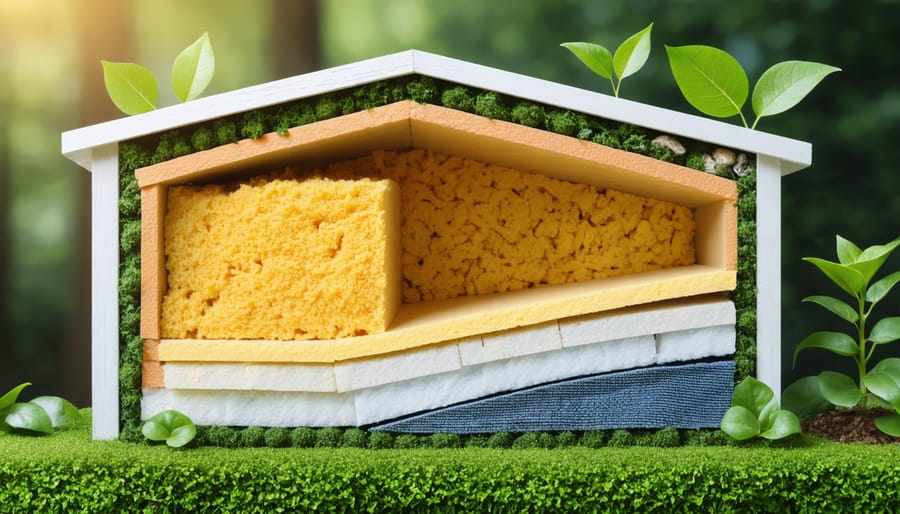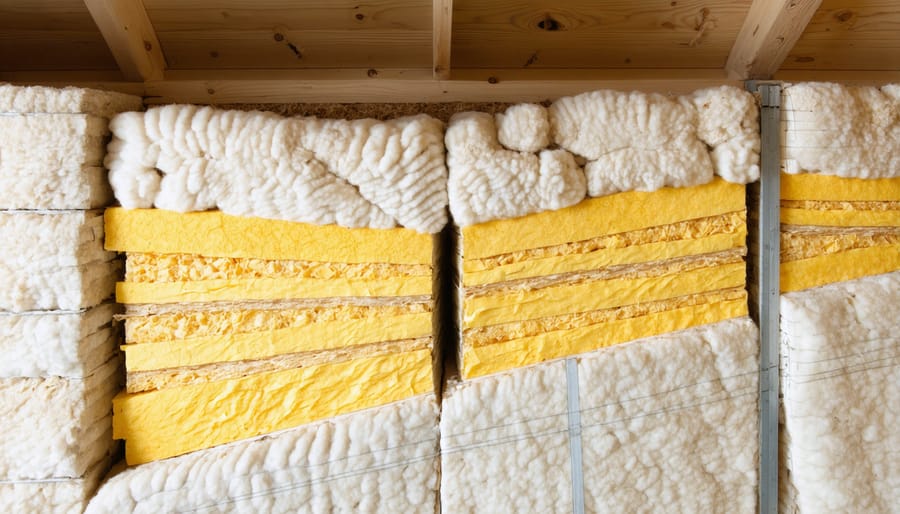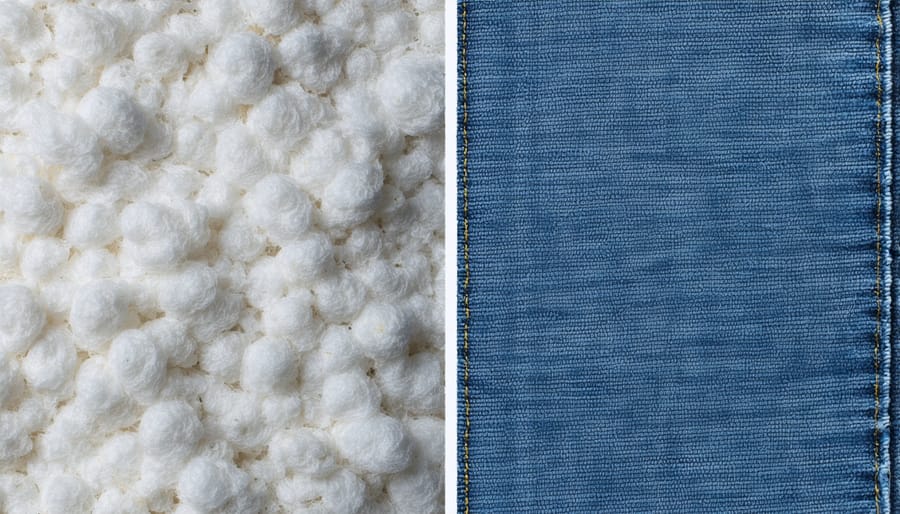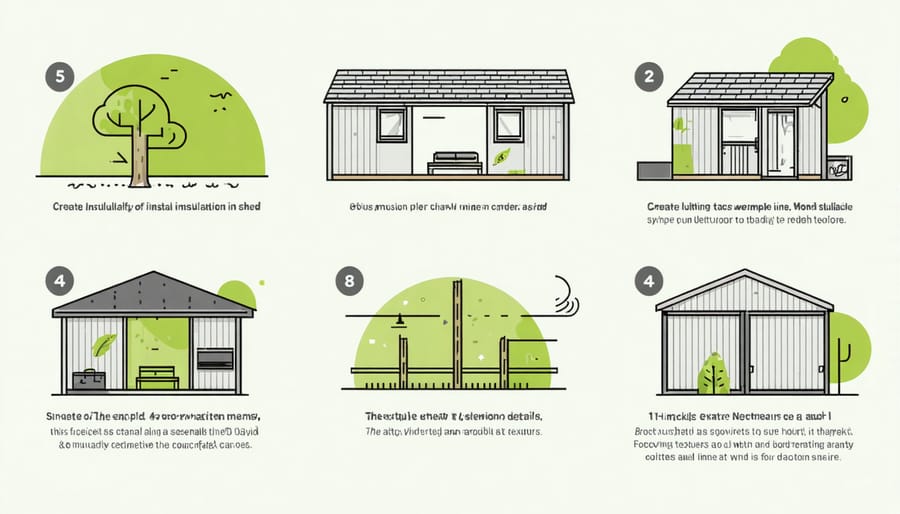Earth-Friendly Shed Insulation That Actually Works (And Saves You Money)

Choose fiberglass batts as your primary insulation for maximum R-value and cost-effective insulation options in outdoor sheds. Properly installed fiberglass delivers superior temperature control and moisture resistance, two critical benefits of shed insulation that protect both your storage items and the structure itself.
Beyond fiberglass, modern foam board insulation offers exceptional performance in limited wall cavity spaces, while eco-friendly alternatives like sheep’s wool and recycled denim provide sustainable solutions without compromising effectiveness. Select your insulation based on three key factors: local climate conditions, shed purpose, and budget constraints.
Consider combining different insulation types for optimal results – use rigid foam board for the walls, fiberglass in the ceiling, and reflective barriers in sun-exposed areas. This layered approach maximizes energy efficiency while ensuring year-round protection for your outdoor storage space.
Natural Fiber Insulation Options
Sheep’s Wool: Nature’s Perfect Insulator
When it comes to natural insulation solutions, sheep’s wool stands out as a remarkable option for your outdoor shed. This sustainable material offers exceptional thermal performance while being completely eco-friendly. Unlike synthetic alternatives, wool fibers naturally regulate humidity by absorbing and releasing moisture without compromising their insulating properties.
One of the most appealing aspects of wool insulation is its ability to maintain consistent temperatures year-round. In winter, it traps warm air within its fibers, while in summer, it helps keep your shed cool. The natural crimp in wool fibers creates millions of tiny air pockets, providing superior insulation value with an R-value between 3.5 and 3.8 per inch.
Installation is straightforward and pleasant, as wool is safe to handle without protective gear. The material comes in batts or rolls that can be easily cut to size and fitted between studs. Unlike fiberglass, wool won’t irritate your skin or airways during installation. It’s also naturally fire-resistant and can actually help improve air quality by absorbing and neutralizing harmful chemicals.
While the initial cost might be higher than synthetic options, wool’s durability and longevity make it a cost-effective choice in the long run. It’s naturally resistant to mold and mildew, requires no chemical treatments, and can last for decades with proper installation. For environmentally conscious shed owners, wool insulation offers the perfect balance of performance and sustainability.

Cotton and Hemp Solutions
For environmentally conscious shed owners, cotton and hemp insulation offer excellent sustainable alternatives to traditional materials. Recycled cotton insulation, made primarily from repurposed denim and other textile waste, provides remarkable thermal performance while giving new life to materials that might otherwise end up in landfills. This chemical-free option is safe to handle and install, making it perfect for DIY projects.
Cotton insulation typically comes in easy-to-install batts that fit snugly between wall studs and ceiling joists. It’s naturally resistant to pests, mold, and fire when properly treated, and it doesn’t cause skin irritation during installation – a significant advantage over fiberglass. Many homeowners appreciate that it doesn’t require protective gear beyond basic dust masks during installation.
Hemp insulation is another eco-friendly option gaining popularity among shed owners. Made from industrial hemp fibers, this material offers excellent thermal and acoustic properties while being naturally resistant to moisture and pests. Hemp insulation is particularly effective at regulating humidity levels, which helps protect your stored items from moisture damage.
Both cotton and hemp options provide R-values comparable to traditional insulation materials, typically ranging from R-3.5 to R-3.7 per inch of thickness. While these sustainable alternatives may cost more upfront than conventional options, they often pay for themselves through energy savings and durability. Plus, their minimal environmental impact makes them an investment in both your shed and the planet.

Recycled Material Insulation
Recycled Denim
For environmentally conscious shed owners, recycled denim insulation offers a unique blend of sustainability and performance. Made from post-consumer blue jeans and other denim materials that would otherwise end up in landfills, this innovative insulation option gives new life to old clothes while providing excellent thermal and acoustic properties.
Recycled denim insulation typically comes in batts or rolls, making it easy to handle and install. It’s naturally fire-resistant and doesn’t contain harmful chemicals or irritants commonly found in traditional insulation materials. Many homeowners appreciate that it’s safe to handle without protective gear, though wearing a dust mask during installation is still recommended.
One of the standout features of denim insulation is its impressive R-value, typically ranging from R-3.5 to R-4.0 per inch of thickness. This means it performs comparably to traditional fiberglass insulation while being more environmentally friendly. The cotton fibers in denim also excel at absorbing sound, making it an excellent choice if you’re using your shed as a workshop or hobby space.
While denim insulation may cost more upfront than conventional options, many users find the investment worthwhile for its eco-friendly benefits and superior comfort during installation. The material is also naturally resistant to mold and mildew, which is particularly important for outdoor structures like sheds.
Cellulose from Recycled Paper
Cellulose insulation made from recycled paper offers an eco-friendly solution for your outdoor shed while maintaining excellent insulating properties. This sustainable material consists of up to 85% recycled newspaper and cardboard, treated with fire-retardant chemicals to ensure safety.
One of the major advantages of cellulose insulation is its superior ability to fill gaps and conform to irregular spaces, making it perfect for sheds with unusual shapes or numerous obstacles. When properly installed, cellulose achieves an R-value of approximately 3.5 per inch, providing effective temperature control in both summer and winter.
Installation can be done through either the dry or wet-spray method. The dry installation involves blowing loose cellulose into wall cavities and attic spaces, while the wet-spray method adds a small amount of water to help the material adhere better to surfaces. For most DIY enthusiasts, the dry method is more practical for shed applications.
Before installation, ensure your shed’s walls are properly sealed and weather-tight. You’ll need to rent a blowing machine from your local hardware store and wear appropriate safety gear, including a dust mask and eye protection. The material should be installed to achieve a consistent density, avoiding any gaps or thin spots that could compromise its effectiveness.
A typical 8×10 shed requires about 15-20 bags of cellulose insulation, making it a cost-effective choice compared to many traditional options.
Modern Eco-Tech Solutions
Recycled Plastic Foam Alternatives
For environmentally conscious shed owners, recycled plastic foam alternatives offer an excellent balance of insulation performance and sustainability. These innovative materials are typically manufactured from post-consumer plastic waste, giving new life to materials that might otherwise end up in landfills.
One popular option is recycled expanded polystyrene (EPS), which maintains the same excellent insulating properties as traditional EPS but with a significantly reduced environmental impact. These panels are often made from recycled packaging materials and can be easily cut to size for your shed walls and ceiling.
Another sustainable choice is recycled polyisocyanurate (PIR) boards, which combine high thermal resistance with eco-friendly credentials. These boards are partially made from recycled plastic bottles and other post-industrial materials, offering excellent R-values while helping reduce plastic waste.
Many manufacturers now offer foam insulation products containing up to 50% recycled content, which doesn’t compromise on performance. These materials are typically moisture-resistant and lightweight, making them ideal for shed applications. They’re also easier to handle during installation compared to traditional options.
When selecting recycled foam alternatives, look for products with third-party certifications that verify their recycled content and environmental claims. While these options might cost slightly more upfront, they often pay for themselves through energy savings while giving you the satisfaction of making an environmentally responsible choice.
Air-Sealed Panels
Structural insulated panels (SIPs) represent one of the most innovative energy-saving insulation techniques available for outdoor sheds. These panels consist of a thick foam core sandwiched between two layers of oriented strand board (OSB), creating an airtight seal that significantly reduces heat transfer.
What makes these panels particularly appealing for eco-conscious shed owners is their sustainable composition and minimal waste during installation. The factory-cut panels arrive ready to assemble, reducing on-site waste and construction time. Many manufacturers now use recycled materials and environmentally friendly foam cores, making them an excellent choice for those prioritizing green building practices.
The seamless construction of air-sealed panels provides superior protection against moisture and drafts, a crucial factor for protecting stored items in your shed. While the initial cost might be higher than traditional insulation methods, the long-term benefits often justify the investment. Users report maintaining consistent temperatures year-round and notice reduced energy costs when using climate-controlled shed spaces.
Installation is relatively straightforward, though it’s recommended to have an extra pair of hands during the process. The panels typically connect through a tongue-and-groove system, creating tight seams that contribute to their excellent insulating properties. For best results, consider working with a professional installer who can ensure proper sealing around windows, doors, and other openings.
Multi-Layer Reflective Systems
Multi-layer reflective systems offer a modern and efficient approach to insulating your outdoor shed. These systems typically consist of multiple layers of reflective foil combined with air-gap spacers, creating an effective barrier against all three types of heat transfer: conduction, convection, and radiation.
The beauty of these systems lies in their slim profile and lightweight nature. A typical multi-layer reflective system is only about 1/4 inch thick, yet provides insulation comparable to much thicker traditional materials. This means you’ll preserve more valuable storage space in your shed while maintaining excellent temperature control.
Installation is relatively straightforward for DIY enthusiasts. The reflective layers come in rolls or sheets that can be easily cut to size with scissors or a utility knife. Most systems include a built-in vapor barrier, eliminating the need for additional moisture protection. For best results, maintain an air gap of at least 3/4 inch between the reflective surface and the wall or roof.
Many homeowners appreciate that these systems are eco-friendly, often containing recycled materials and requiring minimal resources to manufacture. They’re also dust-free and won’t deteriorate over time like some traditional insulation materials. While the initial cost might be higher than basic insulation options, the long-term benefits of durability and space-saving make multi-layer reflective systems an excellent investment for your shed.

Installation and Maintenance Tips
Installing eco-friendly insulation in your outdoor shed doesn’t have to be complicated. Start by thoroughly cleaning the shed’s interior and checking for any gaps or cracks that need sealing. These small openings can significantly impact your insulation’s effectiveness and moisture protection.
For wall insulation, measure each section carefully and cut your chosen material slightly larger than the space to ensure a snug fit. When working with natural materials like sheep’s wool or cotton, wear gloves and a dust mask for safety, even though these materials are less irritating than traditional options.
Start from the top down – insulate the roof first, then walls, and finally the floor. This approach prevents damage to already-installed sections. Use appropriate fasteners or staples to secure the insulation, and don’t compress the material too tightly as this reduces its effectiveness.
To maintain your eco-friendly insulation:
– Inspect quarterly for signs of moisture or pest activity
– Check seals around windows and doors annually
– Ensure proper ventilation remains unobstructed
– Address any leaks promptly to prevent insulation damage
– Brush or vacuum exposed insulation surfaces yearly
For optimal performance, consider adding a vapor barrier when installing in high-humidity areas. Keep stored items slightly away from insulated walls to allow proper air circulation. If using natural materials, remember that some may need replacement sooner than synthetic options, but their environmental benefits often outweigh this consideration.
Remember to document your installation process with photos – this helps track potential problem areas and makes future maintenance easier.
Choosing the right insulation for your outdoor shed is a crucial decision that impacts both your storage space’s functionality and the environment. Throughout this guide, we’ve explored various eco-friendly options that provide excellent thermal protection while minimizing environmental impact. Remember that natural materials like sheep’s wool and recycled denim not only offer outstanding insulation properties but also contribute to a more sustainable future. Whether you opt for cellulose, cork, or cotton-based solutions, prioritizing materials with high recycled content helps reduce waste and energy consumption.
Consider your local climate, budget, and specific needs when making your final choice. While the initial cost of eco-friendly insulation might be slightly higher, the long-term benefits – including reduced energy costs and a smaller carbon footprint – make them worthwhile investments. Don’t forget to properly seal any gaps and ensure adequate ventilation during installation for optimal performance.
By choosing environmentally conscious insulation materials for your shed, you’re not just creating a comfortable storage space – you’re also contributing to a greener, more sustainable world for future generations.

